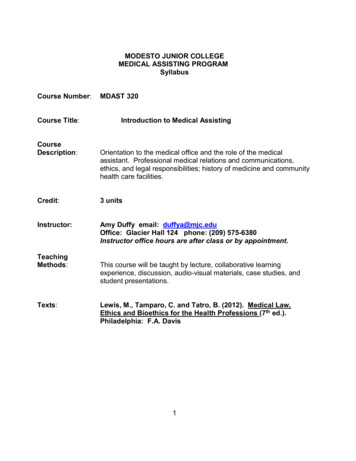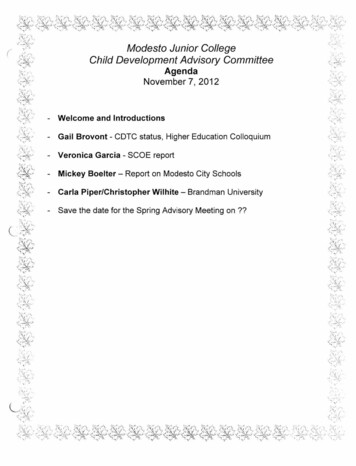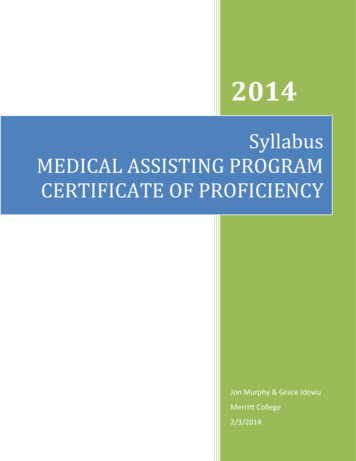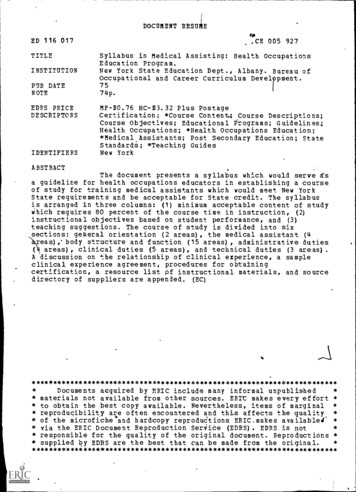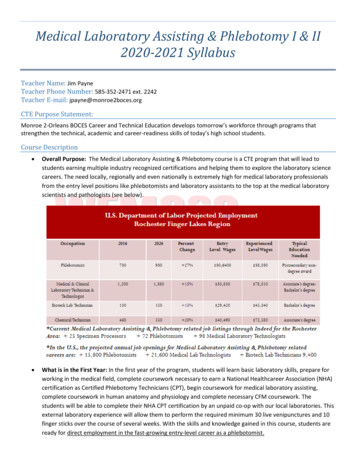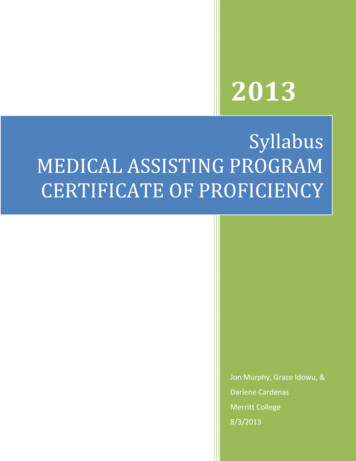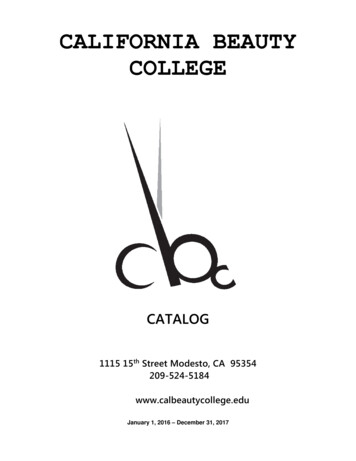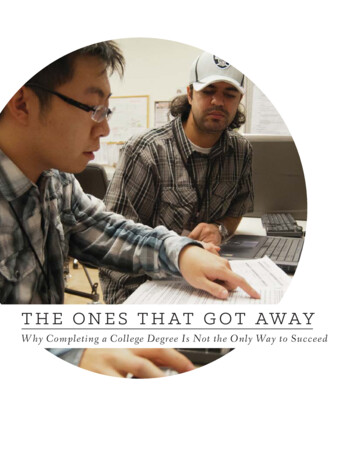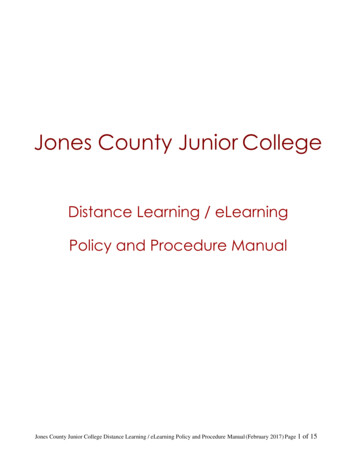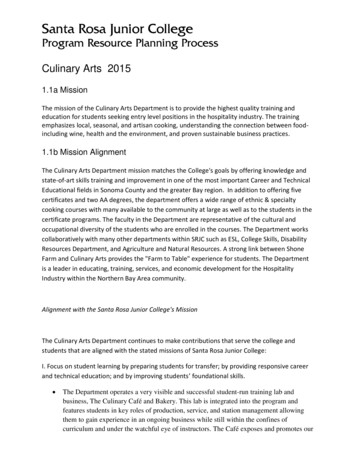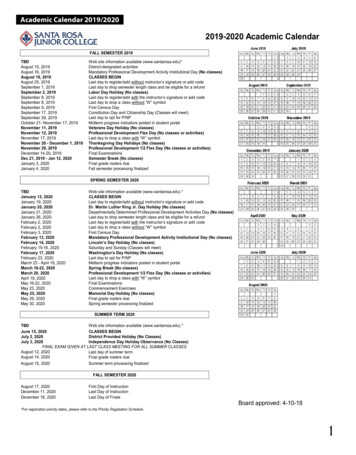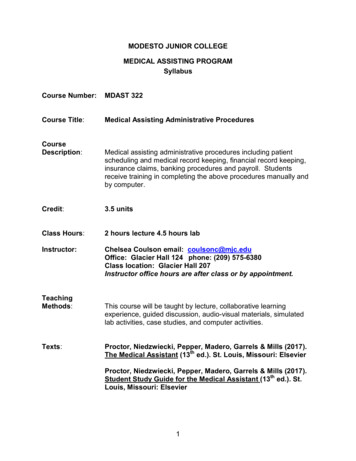
Transcription
MODESTO JUNIOR COLLEGEMEDICAL ASSISTING PROGRAMSyllabusCourse Number:MDAST 322Course Title:Medical Assisting Administrative ProceduresCourseDescription:Medical assisting administrative procedures including patientscheduling and medical record keeping, financial record keeping,insurance claims, banking procedures and payroll. Studentsreceive training in completing the above procedures manually andby computer.Credit:3.5 unitsClass Hours:2 hours lecture 4.5 hours labInstructor:Chelsea Coulson email: coulsonc@mjc.eduOffice: Glacier Hall 124 phone: (209) 575-6380Class location: Glacier Hall 207Instructor office hours are after class or by appointment.TeachingMethods:Texts:This course will be taught by lecture, collaborative learningexperience, guided discussion, audio-visual materials, simulatedlab activities, case studies, and computer activities.Proctor, Niedzwiecki, Pepper, Madero, Garrels & Mills (2017).The Medical Assistant (13th ed.). St. Louis, Missouri: ElsevierProctor, Niedzwiecki, Pepper, Madero, Garrels & Mills (2017).Student Study Guide for the Medical Assistant (13th ed.). St.Louis, Missouri: Elsevier1
MinimumPerformanceStandards:The student will receive one grade from this course. Therequirements for satisfactory completion and minimumperformance in this course will be evaluated by the instructor basedon the student's:I.Tests, quizzes, class assignments, written assignments,and computer assignments.II.Successful completion of entry-level procedures for themedical assistant.Each procedure is initially completed as a Peer Evaluation.The student then has a maximum of three attempts toachieve a satisfactory rating by the instructor for eachprocedure. CAAHEP accreditation requires 100% ofMedical Assisting graduates pass 100% of allcompetenciesFailure to clearly demonstrate any of the Minimum PerformanceStandards will result in failure of the course.If the student’s performance falls below a “C”, the instructor willrequire a counseling session with the student and complete aStudent Contact Sheet.If improvement does not take place, the instructor will initiateanother meeting with the student and complete a Probation Notice.If the student’s performance remains unsatisfactory, the student willneed to repeat the entire course.Any student required to repeat a medical assisting course will berequired to withdraw from the program and reapply to repeat thecourse the following year.GradingScale:The grading policy requires a grade of “C” or better to progress inthe Medical Assisting Program.A 100-90%B 89-80%C 79-70%D 69-60%F 59 and below2
A. COURSE GOALAs a result of satisfactory completion of this course, the student should beprepared to:Perform a variety of administrative tasks related to the medical office suchas; appointment scheduling, billing procedures, banking procedures andmedical records management both in the paper and electronic formats.B. STUDENT LEARNING GOALSMastery of the following learning goals will enable the student to achieve theoverall course goal.Required Learning GoalsUpon satisfactory completion of this course, the student will be able to:a.Operate the office phone system, schedule appointment, maintainpatient records, and handle the mail.b.Interpret the concept of the usual, customary, and reasonable feeby using code manuals and fee schedule.c.Demonstrate knowledge of fee determination, extension of creditand collections.d.Extract from previous bookkeeping and accounting records thenecessary data for the accountant to prepare the required taxrecords and forms.e.Employ computer skills in completion of the computer assignmentswhich cover financial record keeping, insurance claims, bankingfunctions, payroll and medical records.f.Demonstrate of proper application and utilization of courseconcepts regarding office procedures.g.Demonstrate knowledge of insurance principles by abstractinginformation and completing a claim form to the specifications of thecarriers involved for reimbursement.3
COURSE LEARNING OUTCOMESUpon satisfactory completion of this course, the student should be prepared to:1.Demonstrate proper telephone techniques in the medical office.2.Schedule appointment using both manual and computerized methods.3.Properly complete various medical forms.4.Create and manage a patient medical record using manual andcomputer methods.4
CHAPTER 1 Competency-Based Education and the Medical Assistant StudentPREPARATION:Read Chapter 1 in The Medical AssistantComplete Chapter 1 in the Study GuideCONTENT:Competency-based learning is ideal for adult learners who are attempting to understandnew information and achieve new skills. Educators recognize the adult learners cometo the classroom with different work-related experiences and educational background.Therefore, adult students have a wide range of understanding about the knowledge andskills that must be achieved in the program.LEARNING OBJECTIVES:1. Define, spell and pronounce the terms listed in the vocabulary.2. Discuss competency-based education and adult learners.3. Summarize the importance of student portfolios in proving academic successand skill competency.4. Examine your learning preferences and interpret how your learning style affectsyour success as a student.5. Differentiate between adaptive and non-adaptive coping mechanisms.6. Apply time management strategies to make the most of your learningopportunities.7. Integrate effective study skills into daily activities.8. Discuss test-taking strategies that help you take charge of your success.9. Incorporate critical thinking and reflection to help you make mental connectionsas you learn material.10. Analyze healthcare results as reported in graphs and tables.11. Apply problem-solving techniques to manage conflict and overcome barriers toyour success.12. Relate assertiveness, aggressiveness and passive behaviors to professionalcommunication and discuss the role of assertiveness in effective communication.5
COMPETENCIES:Cognitive Knowledge:V.C14.V.C15.II.C6.Relate to following behaviors to professional erentiate between adaptive and non-adaptive copingmechanismsAnalyze healthcare results as reported i:a.graphsb.tablesPROCEDURES:None6
CHAPTER 4Therapeutic CommunicationPREPARATION:Read Chapter 4 in The Medical AssistantComplete Chapter 4 in the Study GuideCONTENT:Therapeutic communication skills developed by the medical assistant help set the toneof care in a healthcare facility. Patients who visit the healthcare facility may not be attheir best, and the way the medical assistant reacts to and interacts with them canmake an incredible difference in whether they view the facility and those who care forthem positively or negatively. These interactions may also affect the patient’s treatmentand recovery.LEARNING OBJECTIVES:1. Define, spell and pronounce the terms listed in the vocabulary.2. Discuss first impressions and patient-centered care.3. Do the following related to communication. Identify styles and types of verbal communication.Identify types of nonverbal communication.Recognize and respond to verbal and nonverbal communication.4. Recognize communication barriers.5. Summarize factors that should be considered when communicating with diversepatient populations.6. Identify techniques for overcoming communication barriers.7. Do the following related to communication during difficult times: Recognize the elements of oral communication using the sender-receiverprocess.Apply feedback techniques, including reflection, restatement, andclarification, to obtain information.Discuss open and closed questions or statements.8. Discuss important factors about therapeutic communication across the life span.9. List and explain the levels of Maslow’s hierarchy of needs.7
COMPETENCIES:Cognitive Knowledge:V.C1.V.C2.V.C3.V.C4.V.C.5.V.C17.Identify styles and types of verbal communicationIdentify types of nonverbral communicationRecognize barriers to communicationIdentify techniques for overcoming communication barriersRecognize the elemnts of oral communication using s senderreceiver processDiscuss the theories of MaslowPsychomotor Skills:V.P1.Use feedback techniques to obtain patient information V.P2.Respond to nonverbral communicationV.P.3.Use medical terminology correctly and pronounced accurately tocommunicate information to providers and patientsAffective active listeningc.nonverbral communicationDemonstrate respect for individual diversity including:a. genderb. racec. religiond. agee. economic statusf.appearanceExplain to a patient the rationale for performance of a procedurePROCEDURES:4-14-2Respond to Nonverbal CommunicationApply Feedback Techniques, Including Reflection, Restatement, andClarification, to Obtain Patient Information8
CHAPTER 7Technology and Written CommunicationPREPARATION:Read Chapter 7 in The Medical AssistantComplete Chapter 7 in the Study GuideCONTENT:The computer can be an effective tool in the medical office. It performs repetitive tasks,reduces errors, speeds up production, recalls information on command, saves time,reduces paperwork, and allows for more creative and productive use of worker’s time.Also, the medical assistant is required to send written communication to patients andother providers as directed by their provider-employers.LEARNING OBJECTIVES:1. Define, spell and pronounce the terms listed in the vocabulary.2. Explain what a personal computer is, and identify input and output hardware forpersonal computer.3. Identify internal computer components, secondary storage devices, and networkand Internet access devices.4. Explain how to maintain computer hardware.5. Identify principles of ergonomics that apply to a computer workstation.6. Differentiate between: System software and application software.Electronic medical records (EMRs) and a practice management system.7. Explain the importance of data backup and other computer network securityactivities performed in the healthcare setting.8. Discuss applications of electronic technology.9. Recognize the elements of fundamental writing skills.10. Explain the guidelines for using capitalization, numbers, and punctuation inbusiness communication.11. Describe each component of a professional business letter.9
12. Summarize the formats for business letters and memorandums.13. Compose professional correspondence using electronic technology.COMPETENCIES:Cognitive Knowledge:V.C7.V.C8.VI.C8.VI.C11.XII.C7.Recognize elements of fundamental writing skillsDiscuss applications of electronic technology in professionalcommunicationDifferentiate between electronic medical records (EMR) and apractice management systemExplain the importance of data back-upIdentify principles of:b.ergonomicsPsychomotor Skills:V.P8.Compose professional correspondence utilizing electronictechnologyPROCEDURES:7-17-2Compose a Professional Business LetterCompose a Professional E-mail10
CHAPTER 8Telephone TechniquesPREPARATION:Read Chapter 8 in The Medical AssistantComplete Chapter 8 in the Study GuideCONTENT:This chapter is designed to help you to recognize how telephone management affectsthe caller’s regard for the office staff and the physician. The tone or climate of the officeand its responsiveness to patients are transmitted over the phone. In addition tofocusing on attitude development, information relating to the operation of equipmentand the placing of calls will also be stressed.LEARNING OBJECTIVES:1. Define, spell and pronounce the terms listed in the vocabulary.2. Identify and explain the features of a multiple-line telephone system, and alsoexplain how each can be used effectively in a healthcare facility.3. Do the following related to effective use of the telephone: Discuss the telephone equipment needed by healthcare facility.Summarize active listening skills.Demonstrate effective and professional telephone techniques.Consider the importance of tone of voice and enunciation.4. Explain the importance of thinking ahead when managing telephone calls; also,describe the correct way to answer the telephone in the office5. Discuss the screening of incoming calls, and list several questions to ask whenhandling an emergency call.6. Do the following related to taking message: Document telephone messages accurately.List the seven elements of a correctly handled telephone message.Report relevant information concisely and accurately.7. Discuss various types of common incoming calls and how to deal with each.8. Discuss various types of special incoming calls and how to deal with each.11
9. Discuss how the medical assistant should handle various types of difficult calls.10. Discuss typical outgoing calls, including why knowledge of time zones and longdistance calling is necessary.11. Discuss the use of a telephone directory, and describe how answering servicesand automatic call routing systems are used in a healthcare facility.12. Discuss the legal and ethical issues related to telephone techniques.COMPETENCIES:Psychomotor Skills:V.P6.V.P7.V.P11.Demonstrate professional telephone techniquesDocument telephone messages accuratelyReport relevant information concisely and accuratelyPROCEDURES:8-18-2Demonstrate Professional Telephone TechniquesDocument Telephone Messages and Report Relevant Information Concisely andAccurately12
CHAPTER 9Scheduling Appointments and Patient ProcessingPREPARATION:Read Chapter 9 in The Medical AssistantComplete Chapter 9 in the Study GuideCONTENT:In this chapter you will become acquainted with the task of organizing and coordinatingappointments. You may first perceive this task as somewhat simplistic and insignificant.On the contrary, the responsibilities of scheduling appointments are indeed challengingand require intelligence and good organizational skills. It is here in schedulingappointments that the physician’s entire medical practice is orchestrated.LEARNING OBJECTIVES:1. Define, spell and pronounce the terms listed in the vocabulary.2. Describe guidelines to establishing appointment schedule and creating anappointment matrix.3. Discuss the advantages of computerized appointment scheduling.4. Discuss appointment book scheduling and explain how self-schedulingcan reduce the number of calls to the healthcare facility.5. Discuss the legality of the appointment scheduling system.6. Discuss pros and cons of various types of appointment managementsystems.7. Discuss telephone scheduling and identify critical information required forscheduling appointments for new patients.8. Discuss scheduling appointments for established patients.9. Discuss how the medical assistant should handle scheduling other typesof appointments.13
10. Do the following related to special circumstances in scheduling: Discuss several methods of dealing with patients who consistentlyarrive late.Recognize office policies and protocols for reschedulingappointments.Discuss how to deal with emergencies, provider referrals, andpatients without appointments.11. Discuss how to handle failed appointments and no-shows, as well asmethods to increase appointment show rates.12. Discuss how to handle cancellations and delays.13. Discuss patient processing, including the importance of the receptionarea.14. Describe how to prepare for patient arrivals, including patient check-inprocedures.15. Explain why using the patient’s name as often as possible is important, aswell as how the medical assistant can make patients feel at ease.16. Describe registration procedures, including obtaining a patient history.COMPETENCIES:Cognitive Knowledge:VI.C1.VI.C2.VI.C3.VI.A1.Identify different types of appointment scheduling methodsIdentify advantages and disadvantages of the followingappointment systems:a.manualb.electronic appointment systemsIdentify critical information required for scheduling patientproceduresDisplay sensitivity when managing appointments14
Psychomotor Skills:V.P4.VI.P1.VI.P2.VII.P3.Coach patients regarding:a.office policiesManage appointment schedule using established prioritiesSchedule a patient procedureObtain accurate patient billing informationAffective Behavior:VI.A1.Display sensitivity when managing appointmentsPROCEDURES:9-19-29-39-49-5Establish the Appointment MatrixSchedule a New PatientCreate the New Patient BrochureSchedule an Established PatientSchedule a Patient Procedure15
CHAPTER 10Daily Operations in the Ambulatory Care SettingPREPARATION:Read Chapter 10 in The Medical AssistantComplete Chapter 10 in the Study GuideCONTENT:In the healthcare facility, employees must arrive before patients to prepare for thepatients. The preparation can differ based on the size of the facility and the practice’spolicies on preparation. Also one of the most important responsibilities of the medicalassistant is to manage the equipment and supplies in the medical office.LEARNING OBJECTIVES:1. Define, spell and pronounce the terms listed in the vocabulary.2. Describe the administrative and clinical opening duties performed by the medicalassistant.3. Discuss the administrative and clinical closing responsibilities performed by themedical assistant, as well as daily and monthly duties.4. Explain safety and security procedures important in the healthcare facility.5. Do the following related to equipment in a medical practice: Describe the elements of an equipment inventory list.Explain the purpose of routine maintenance of administrative and clinicalequipment.Explain the steps of creating a maintenance log, performing maintenance,and documenting the maintenance.Describe the medical assistant’s role in ordering equipment.6. Do the following related to supplies in the medical practice. Discuss the elements on a supply inventory list.List the steps involved in completing an inventory.Perform an inventory with documentation.Prepare a supply order.7. Describe how the healthcare facility utilizes USPS and other delivery agencies.8. Use proper body mechanics.16
COMPETENCIES:Cognitive Knowledge:VI.C9.VI.C10.XII.C7.Explain the purpose of routine maintenance of administrative andclinical equipmentList steps involved in completing an inventoryIdentify principles of:a.body mechanicsPsychomotor Skills:VI.P8.VI.P9.XII.P3.Perform routine maintenance of administrative or clinical equipmentPerform an inventory with documentationUse proper body mechanicsPROCEDURES:10-110-210-310-4Perform Equipment InventoryPerform Routine Maintenance of Administrative or Clinical EquipmentPerform an Inventory of Supplies While Using Proper Body MechanicsPrepare a Purchase Order17
CHAPTER 11The Health RecordPREPARATION:Read Chapter 11 in The Medical AssistantComplete Chapter 11 in the Study GuideCONTENT:The two types of patient’ records are the paper health record and the EHR. With theadvances in computer technology, the paper health record has been shown to be muchless efficient than EHR. Having learned the concepts related to organizing the patientrecord, you are ready to integrate the organization of medical records collectively. Thechapter introduces filing management systems and mechanics related to maintainingequipment, taking inventory and managing personnel records. The legal implications ofthe medical record, filing, retrieval and storage must be continuously emphasized.LEARNING OBJECTIVES:1. Define, spell and pronounce the terms listed in the vocabulary.2. Name and discuss the two types of patient records.3. State several reasons that accurate health records are important.4. Differentiate between objective and subjective information in creating a patient’shealth record.5. Explain who owns the medical record.6. Distinguish between an electronic health record (EHR) and an electronic medicalrecord (EMR).7. Do the following related to healthcare legislation and EHRs: Explain how the American Recovery and Reinvestment Act (ARRA)applies to the healthcare industry.Define
The computer can be an effective tool in the medical office. It performs repetitive tasks, reduces errors, speeds up production, recalls information on command, saves time, reduces paperwork, and allows for more creative and productive use of worker’s time. Also, the medical assistant
